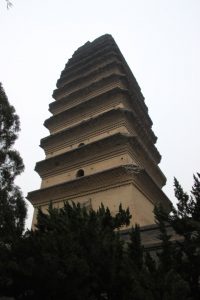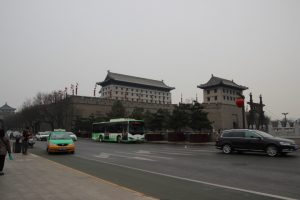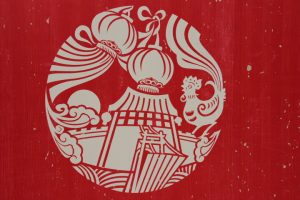This morning we left the old city at the South Gate and upon crossing the moat we entered the very modern high rise section of Xi’an. It was interesting that within a kilometre the shiny granite and glass towers selling Prada and other named clothing brands changed to multi-storey apartments and old single unit shops selling everyday items.
We found in the grounds of the Jianfu Temple, the Little Goose Pagoda. The pagoda is described as a rather delicate building of 15 progressively smaller tiers. It was built at the beginning of the 8th century AD and housed Buddhist scriptures brought from India by a pilgrim called Yi Jing. The top of the pagoda was shaken off by an earthquake in the mid 16th century which left the rest of the 43m high structure intact except for some damage to the corners, presumably caused by the falling debris. Admission was free but at the ticket office upon showing our passports, which is usual at such sights, we were warned that because of our age we were not allowed to climb the pagoda!!
The grounds are very pleasant and peaceful and are used by Saturday morning art classes. We were spotted upon entry who were in a circle being instructed by their teacher and when we were leaving a group of the junior school age pupils and their teacher ran towards us and with good English asked for us to participate in a team photo. This follows one of the party being invited to participate in a photograph for the family album!







We returned to the South Gate and entered through a parkway and across a drawbridge, all in the middle of a giant roundabout. When the South Gate and adjoining walls were renovated it was decided to open three arches either side of the central gate in order to accommodate the traffic and allow it to flow more freely.
Xi’an is one of the few cities in China where the city walls are still standing. They were built in the 14th century, are 12m high, surrounded by a moat and form a rectangle with a perimeter of 14km. It is possible to walk the entirety of the walls, but we chose not to do that today! A model on the wall gives one an idea of how grand and big the old city of Xi’an was at the time of the Silk Road. The walls originally enclosed 83 sq. km which is an area many times larger than today’s city centre. Adjacent to the South Gate was the East Market of the imperial city of the Tang dynasty which was described as a centre of business and handicrafts, dotted with numerous stores and business men. It handles all treasures and rarities from all directions under the sun. From the walls one can see the Hua Pagoda of the Baoqing Temple built in 1451. Close to this pagoda and the walls are the rebuilt houses of artisans that sold their wares nearby.






















